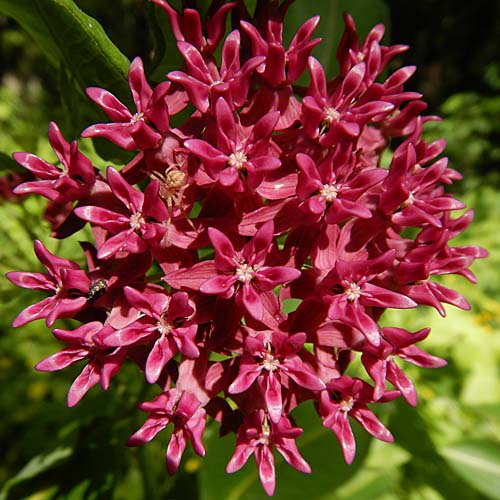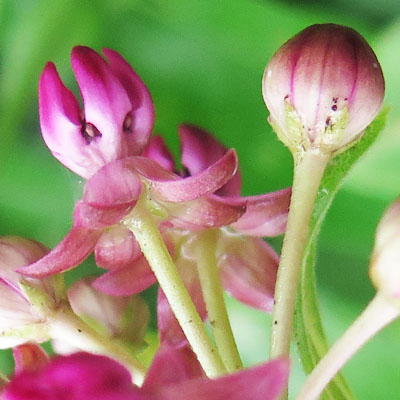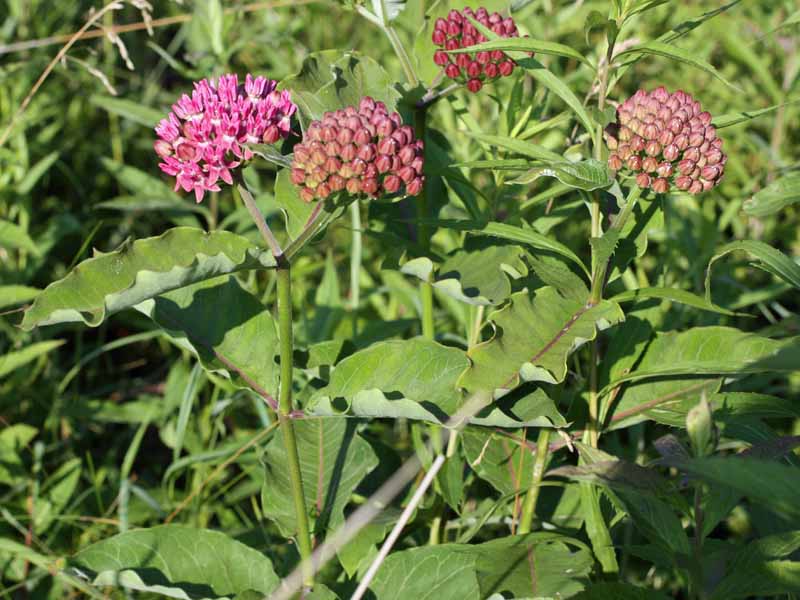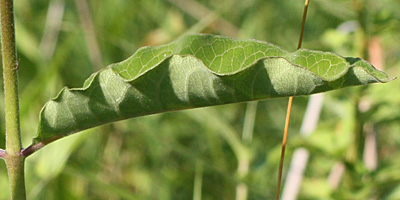Asclepias purpurascens, purple milkweed, is a big showy native perennial herbaceous plant that blooms in the summer. In NJ, it is on the list of 'Endangered Plant Species and Plant Species of Concern' 2022. In 2016, it was not on the list suggesting that populations have disappeared!!
Flowers
Inflorescence/Flower cluster:
One or two big flower clusters emerge at the top of the stem from the axil of the upper leaves. The hemispherical shaped clusters are about 2 to 3 inches across with many flowers. All the flowers in the cluster originate from a single point and the cluster called an umbel.


Individual Flower:
The showy flowers are distinctively a deep purple/red magenta color that can be easily spotted.
If you look at the individual flowers, you will easily notice it does not look like a traditional flower.
Flower structure of the Asclepias purpurascens purple milkweed: Actually, all the milkweeds have similar structure. The flower has both male and female parts. It has a corolla that separates out to 5 petals and has a 5 parted calyx (sepals).
In the labeled photo below, inside the petals is a circle of 5 hoods each containing a horn. The hoods hold nectar which attracts insects. These hoods encircle the gynostegium. The gynostegium (whitish part in the center) is a column of partially fused stamens and the pistil. There are 5 stamens.
The anthers, surrounding the outside of the gynostegium, are split into a pair of anther pouches with a slit between the anther pouchs. The slit is called the stigmatic slit. Inside of the anther pouches are pollen sacs. Instead of individual pollen grains, the grains are together in a sac called the pollinium (pollinia - plural). The pair of pollinia(anther sacs) are connected to the corpusculum, the dark object, by translator arms. These three parts, corpusculum, translator arm & pollinia, together are callled a pollinarium.
Now for the female parts. In the gynostegium are 5 receptive stigmatic surfaces that are inside of 5 stigmatic chambers. Access to the receptive stigmatic surfaces is through the stigmatic slits. Interestingly, each flower has two ovaries. Two stigmatic chambers are connected to one ovary and 3 stigmatic chambers are connected to the other ovary.

Another view of the horns that emerge from the hoods. Note that the incurved horns grow horizontally over and down toward the gynostegium (center whitish part). The color of the flowers and the horns distinguish purple milkweed from common milkweed. See common milkweed click here



Diagram of a general milkweed flower:
- hn: horn
- cp: corpusculum
- ss: stigmatic slit
- hd: hood
- pt: petal, reflexed
- cp: corpusculum
- ta: translator arm
- ps: pollinia (pollen sac)

Internet Archive Book Images, No restrictions, via Wikimedia Commons
Pollination
Pollinating insects must be compatible with the specialized flower structure of milkweeds. The interesting pollination process is described in detail in the Asclepias syriaca, common milkweed page with references: click here.
Fruit
The purple milkweed seed pods (follicles) are up to 6 inches long, wider at the base and coming to a point at the tip. They are smooth. Purple milkweed with its smooth follicles can be distinguished from the common milkweed that has prickly follicles.
Frequently, purple milkweed does not set seed!


Plant - Leaves - Habitat


The leaves are simple, opposite and paired not whorled.
They are ovate-oblong (wider at the base and rectanglar with rounded ends) to elliptic (broadest in the middle). The leaves are about 6 inches long and 2 inches wide.
The upper surface is dark green and hairless while the lower surface is lighter green and hairy.
The leaf has a prominent midrib. The midrib may be red-brownish sometimes. The many smaller veins extending from the midrib to almost the edge have a distinctive pattern with the veins almost parallel to each other and perpendicular to the midrib.
The margins of the leaf are smooth but wavy (up and down).
Like other milkweeds, when the leaves or stems of purple milkweed are broken, they produce a milky latex. This liquid contain various levels of toxic cardiac glycoside compounds which makes the plants toxic to most insects and animals but not deer.
Smooth but wavy edges of the leaf.

Redish midrib and venation of a leaf.

Leaf underside paler and hairy.

Rarity: In NJ it is S3 (Vulnerable) 2022. However in many of the states where it is native, the plant is a species of special concern - S2 (Imperiled), S1 (Critically Imperiled). Several states have conservation efforts to save the purple milkweed.
Text by Millie Ling and all photos by Hubert & Millie Ling. Photos: Flowers - summer, Great Swamp and Somerset county under power lines.
Additional information
Additional information / references:
- The USDA website shows Asclepias purpurascens nativity in the US down to county level and other information: https://plants.usda.gov/home/plantProfile?symbol=ASPU2
- The Intricate Dance of Milkweed Pollination: has a good drawing
https://www.hachettebookgroup.com/articles/the-intricate-dance-of-milkweed-pollination/ - USDA Milkweed Pollination Biology: excellent description
https://www.nrcs.usda.gov/Internet/FSE_PLANTMATERIALS/publications/nvpmctn12764.pdf - USDA plant of the week: Purple Milkweed https://www.fs.usda.gov/wildflowers/plant-of-the-week/asclepias_purpurascens.shtml
- New England Plant Conservation Program for Purple Milkweed https://www.nativeplanttrust.org/documents/30/Asclepiaspurpurascens.pdf
- Massachusetts Natural Heritage & Endangered Species Program https://www.mass.gov/doc/purple-milkweed/download?_ga=2.212842966.397096803.1687391073-195183305.1684537125
- NatureServe - rarity & distribution. https://explorer.natureserve.org/Taxon/ELEMENT_GLOBAL.2.145205/Asclepias_purpurascens
- Key to NJ Milkweeds: GoBotany. https://gobotany.nativeplanttrust.org/dkey/asclepias/#all